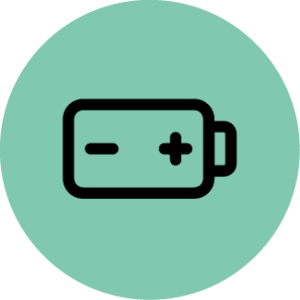In a world of innovation and technology, it’s only fitting that hearing aids continue to advance at a remarkable pace. The landscape of hearing solutions has evolved dramatically (1), offering individuals with hearing loss the chance to embrace life with greater clarity and confidence than ever before (2). The expert review team at Fortune Recommends™ set out to uncover the best hearing aids of 2024, exploring the latest offerings from leading manufacturers.
Our team of experts, audiologists, and consumers with hearing loss conducts thorough evaluations of dozens of over-the-counter and prescription hearing aid models. Through first-hand testing, they scrutinize each device’s performance across various parameters, including sound quality, ease of use, design, connectivity options, and affordability. During our ongoing process, we’re continually testing new products to ensure our list stays up to date with the latest and greatest products.
Best hearing aid overall
The Jabra Enhance Select 300 hearing aids are our top pick for the best hearing aids overall because they have intuitive features, come with Bluetooth connectivity, and boast advanced sound processing and noise reduction. Our product testers also found them more comfortable to wear than several other hearing aids they tested.
Our picks for the best hearing aids in 2024
Best over-the-counter hearing aids of 2024
- Best affordable hearing aids: Audien Atom 2
- Best sound quality: Jabra Enhance Select 300
- Best invisible hearing aids: Eargo7
- Best for personalization: Hear.com
- Best hearing aids for seniors: Lexie B1
- Best OTC hearing aids: MDHearing
- Best Bluetooth hearing aids: Lexie B2
Best prescription hearing aids of 2024
- Best hearing aids for severe hearing loss: Phonak Audéo Lumity
- Best CROS hearing aids: Signia Pure Charge&Go
- Best hearing aids for tinnitus: ReSound Omnia
- Best rechargeable hearing aids: Starkey Evolv AI
How do hearing aids work?
Hearing aids are sophisticated electronic devices that operate through a series of key components and processes (8). First, microphones within the hearing aid capture surrounding sounds, converting them into electrical signals. These signals are then amplified by an internal amplifier, making them louder and more audible.
Modern digital hearing aids employ advanced signal processing algorithms to fine-tune the captured sounds. This involves tasks such as noise reduction to minimize background noise interference, directional processing to focus on specific sound sources, and frequency shaping to adjust amplification levels across different frequency ranges, aligning them with the user’s unique hearing profile.
After processing, the amplified and optimized sound is delivered to the user’s ear canal through a small speaker or customized earpiece. This allows wearers to hear improved sound quality, making communication and overall engagement with their surroundings more accessible. Hearing aids are customized to each individual’s hearing needs, with audiologists or hearing specialists conducting assessments to tailor the settings precisely.
Read more about how hearing aids work.
Compare hearing aids
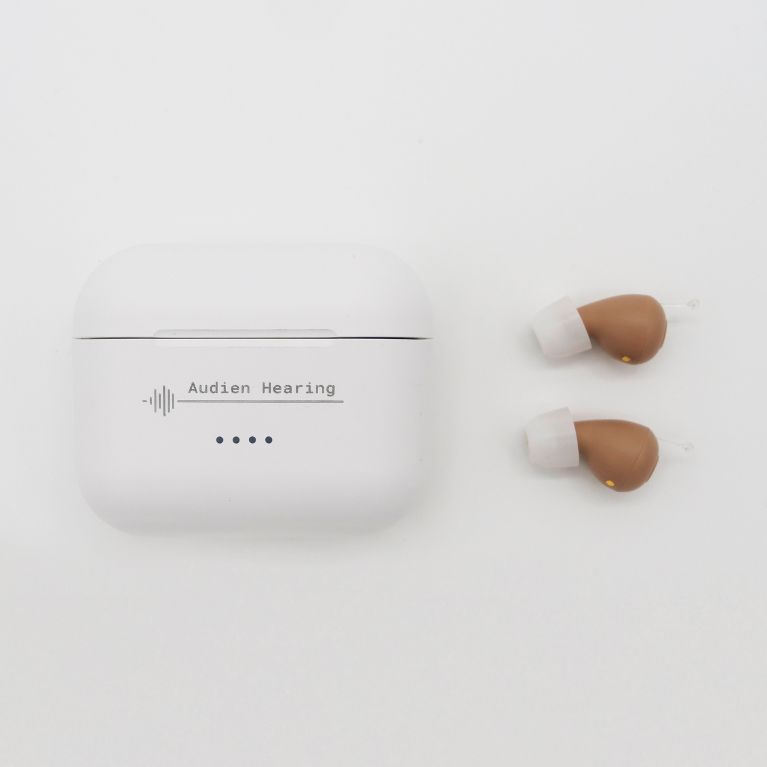
|

|
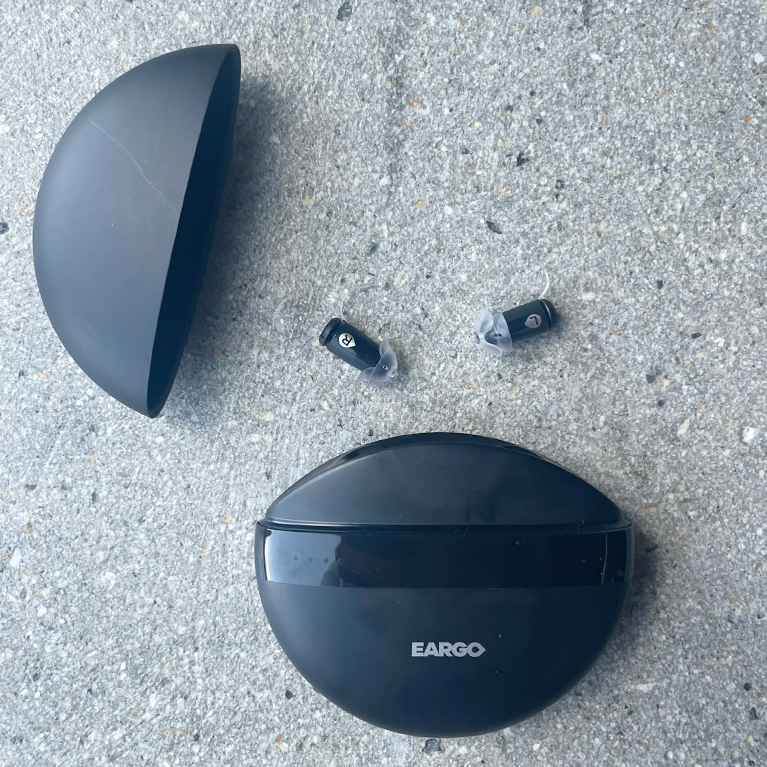
|

|

|
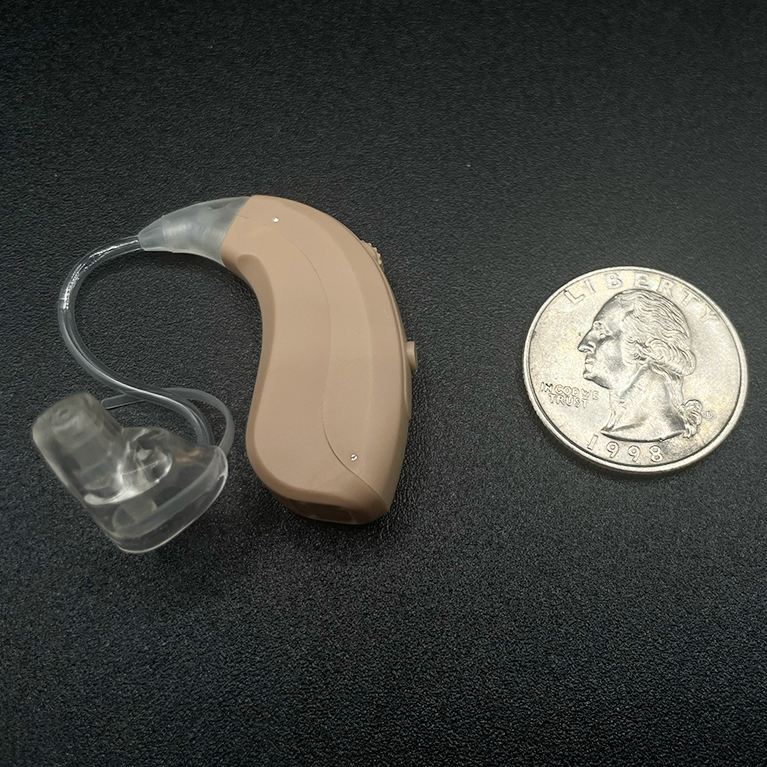
|
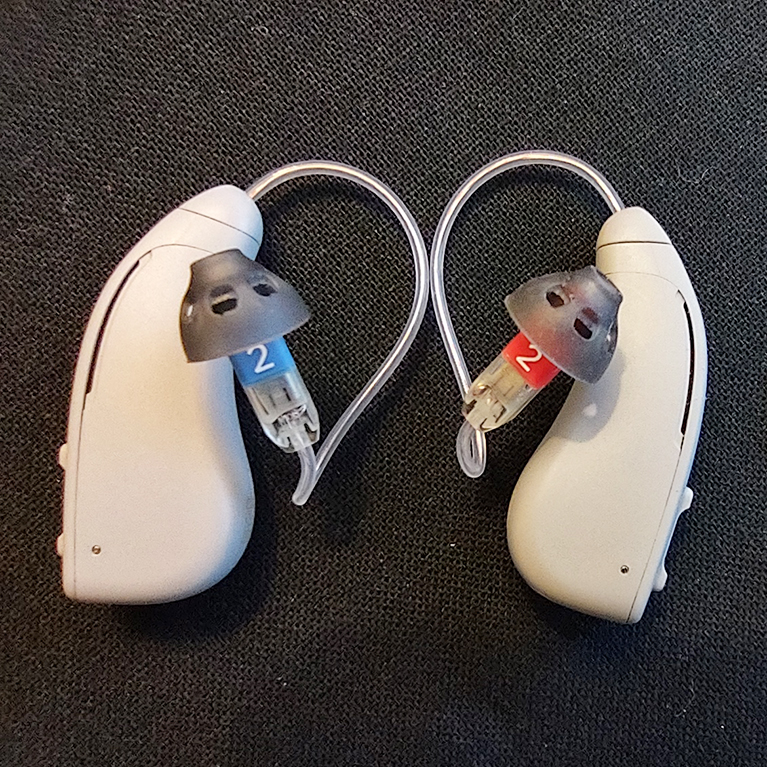
|

|

|
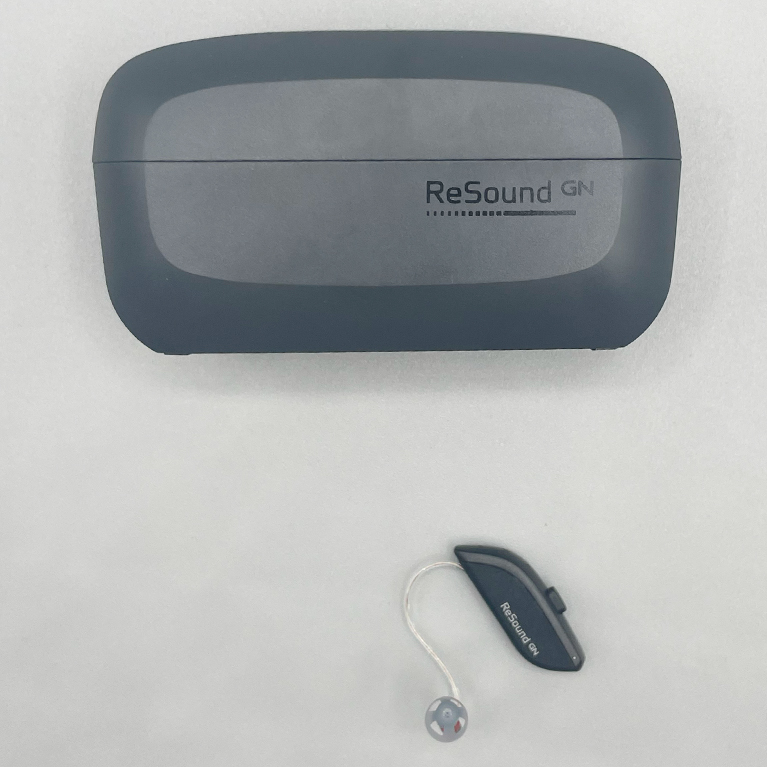
|
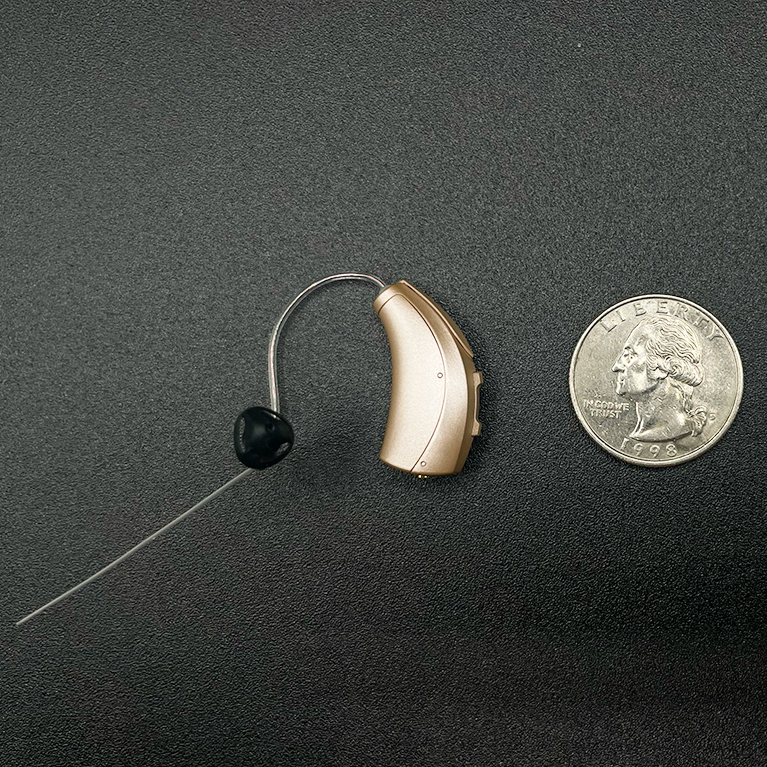
|
|
| Audien Atom 2 | Jabra Enhance Select 300 | Eargo 7 | hear.com | Lexie B1 | MDHearing | Lexie B2 Plus | Phonak Audéo Lumity | Signia Pure Charge&Go | ReSound Omnia | Starkey Evolv AI | |
| Rating | |||||||||||
| Price per pair | $189 | Basic: $1,795; Premium: $1,995 | $2,950 | $1,500-$6,000 | $799 | $297-$699 | $999 | $2,600-$6,500 | $3,198 -$4,798 | $3,200-$6,500 | $4,300-$7,500 |
| Style | ITE | Behind the ear (BTE) | ITE | Varies | Receiver-in-canal (RIC) | BTE; in the ear (ITE) | RIC | BTE | BTE | BTE; in the canal (ITC); receiver in ear (RIE); completely in canal (CIC) | BTE; RIC; ITE; ITC; CIC; invisible in the canal (IIC) |
| Battery | Rechargeable | Rechargeable | Rechargeable | Rechargeable | Disposable | Rechargeable | Rechargeable | Rechargeable | Rechargeable | Rechargeable and disposable | Rechargeable and disposable |
| Bluetooth | No | Yes | No | Yes | Yes | Yes | Yes | Yes | Yes | Yes | Yes |
| Warranty | One year | Basic: one year; Premium: three years | Two years | One to three years | One year | One year | One year | Depends on the retailer | Three years | Depends on the retailer | Two years |
Best affordable hearing aid: Audien Atom 2
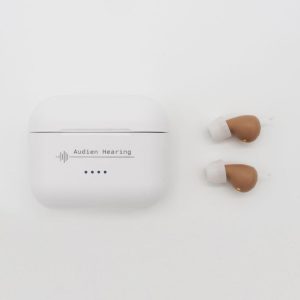

Key product features
What you should know
The Audien Atom 2 hearing aids deliver exceptional value for those with mild to moderate hearing loss, offering ease of use, comfort, and essential features like wireless charging and UV sanitation. This all comes at a budget-friendly price point without advanced technology or audiology support.
- After testing, our product reviewers noted that the hearing aids were easy to use and had straightforward features, such as four listening modes, a wireless charging case with additional charges, and a UV sanitation light.
- Audien is known for their affordable over-the-counter hearing aids, with some versions costing as little as $189 a pair.
- They’re a great option if you have mild to moderate hearing loss and are looking for a budget-friendly hearing aid.
- The hearing aids stay put—our testers didn’t notice them moving when they shook their heads.
Why we like Audien Atom 2 as best affordable
Audien is known for its affordable over-the-counter hearing aids, with some versions costing as little as $189 a pair. Their Audien Atom 2 hearing aids are a cost-effective option if you have mild to moderate hearing loss and are looking for budget-friendly hearing aids.
Ease of use
Audien’s Atom 2 hearing aids are their most powerful in-the-ear version. After testing, our product reviewers noted that the hearing aids were easy to use and had straightforward features, such as four listening modes, a wireless charging case with additional charges, and a UV sanitation light.
Comfort
Our testers also found them to be lightweight and comfortable with none of that “congested” feel you get with some hearing aids. They also stay put—our testers didn’t notice them moving when they shook their heads.
The hearing aids may lack advanced features and technology, but you can still enjoy clear and comfortable hearing without the burden of a hefty price tag. However, you’ll also sacrifice audiology support.
Check out our complete Audien hearing aids review for more insights on this brand. Or, see more of the best affordable hearing aids to find the best option for you.
What customers are saying
Amazon users like how the Atom 2 reduces background noise, that they are comfortable enough to wear all day, and that the controls are easy to use and settings easy to adjust.
“I’ve only owned these hearing aids for three days but they are working out for me quite well. The ease of use and the quality of sound is superior to anything else I have tried. They are comfortable to wear and easy to use with automatic on and off. I love the UV cleaning idea, and the small size of the charging case. The battery life is excellent.”
Jeannie M., Verified Amazon reviewer
“These are my first hearing aids,” begins verified Amazon reviewer Mike. “The manual was clear, straightforward, and complete. The hearing aids are very comfortable in place. There is some squeal as you put them in place but once in place it’s gone. I have mild to moderate hearing loss so I only needed the second of five volume levels. There are four different environments you can select: conversation, restaurants, TV, and outdoors. You can also change volume settings when they are in place since there are different tones for all of the settings. They work great.”
Specs
| Style | ITE |
| Battery | Rechargeable |
| Bluetooth | No |
| Prescription | No |
| Warranty | One year |
| Financing | Yes |
| Dimensions | 0.74”L x (0.15” x 0.15″W) x 1.65’’H |
Best hearing aid overall: Jabra Enhance – Select 300
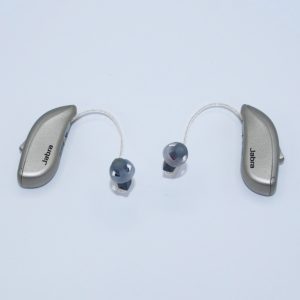

Key product features
What you should know
The Jabra Enhance Select 300 hearing aids emerge as the top pick for their unparalleled sound clarity, sleek design, and seamless Bluetooth integration, making them perform in challenging listening environments. Our extensive testing confirms their comfort and superior audio performance.
- During testing, our staff found them to be so comfortable that they thought they had misplaced them—but the devices were still in their ears.
- High price tag for an OTC hearing aid, but quality is on par with prescription brands.
- They are Jabra’s most inconspicuous model when worn, making them an attractive choice if you prioritize aesthetics and want your hearing aids.
- The Jabra Enhance Select 300 hearing aids are equipped with advanced sound processing and noise reduction features.
Why we like Jabra Enhance Select 300 as best overall
The Jabra Enhance Select 300 hearing aids stand out as a superb overall choice due to their advanced technology, discreet design, and user-friendly features. These hearing aids are designed to provide users with a remarkable auditory experience that combines clarity and comfort.
Jabra Enhance offers two Select 300 models: Basic, which comes pre-programmed to fit, set up, and manage yourself out of the box; and Premium, which is custom-programmed to your unique hearing needs.
Comfort
One of the standout features of these hearing aids is their sleek and comfortable design. They are Jabra’s most inconspicuous model when worn, making them an attractive choice if you prioritize aesthetics and want your hearing aids to blend almost seamlessly into your daily life. During testing, the our staff found them to be so comfortable that they thought they had misplaced them—but the devices were still in their ears.
Sound quality
The Jabra Enhance Select 300 hearing aids are equipped with advanced sound processing and noise reduction features, which enhance sound quality and speech understanding in a variety of environments.
There are two other versions of the Jabra Enhance:
- Select 50: best for quieter situations like watching TV at home
- Select 100: for active lifestyles and tricky situations like conversations at a noisy restaurant
We like the Select 300 of all the models because it has the best sound processing. They’re ideal for the most complex listening situations, such as hearing multiple people at a loud gathering.
Connectivity
The Jabra Enhance Select 300 also comes with Bluetooth connectivity, allowing users to wirelessly connect to their smartphones and other devices. This feature enables you to stream phone calls, music, and other audio directly to their hearing aids, enhancing your overall listening experience and convenience.
However, our testers did find the music streaming to be a bit fuzzy on the Select 300. But this was a small downside to the benefits they enjoyed, such as ease of use, comfort, and listening quality.
For more information, check out our Jabra hearing aids review.
Specs
| Style | BTE |
| Battery | Rechargeable |
| Bluetooth | Yes |
| Prescription | No |
| Warranty | Basic: One year; Premium: Three years |
| Financing | Yes |
| Dimensions | 1.4″L x 3.9″W x 2.7″H |
Best invisible hearing aid: Eargo 7
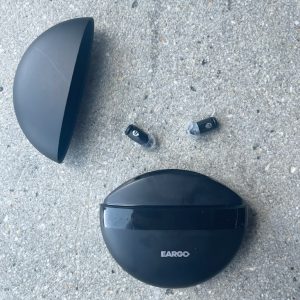

Key product features
What you should know
The Eargo 7 hearing aids stand out for their virtually invisible design and advanced sound amplification, making them great for those seeking a discreet yet effective hearing solution. Despite minor sound quality issues, their ease of use and comfort are highly praised.
- Our product testers found the sound to be a bit tinny or echoey despite changing the noise reduction in the available app.
- The Eargo 7 hearing aids are easy to insert, remove, and clean, and they come with a convenient charging case.
- The Eargo 7 hearing aids are an exceptional choice if you’re looking for “invisible” hearing aids, thanks to their unique and discreet design.
- Eargo’s innovative design allows for natural sound amplification, preserving the nuances of speech and environmental sounds.
Why we Like Eargo 7 as best invisible
The Eargo 7 hearing aids are an exceptional choice if you’re looking for invisible hearing aids, thanks to their unique and discreet design. Like Eargo’s previous versions, its Eargo 7 devices sit deep within the ear canal, making them virtually invisible when worn. Their inconspicuous appearance addresses the cosmetic concerns if you prefer a discreet hearing solution (3), allowing you to regain your hearing without drawing attention to your ears.
Performance
Despite their small size, the Eargo 7 hearing aids offer impressive performance. They incorporate advanced technology that helps ensure you can hear comfortably in various environments. Additionally, Eargo’s innovative design allows for natural sound amplification, preserving the nuances of speech and environmental sounds while minimizing the discomfort or occlusion effect often associated with in-ear hearing aids.
User experience
The user-friendliness of Eargo 7 further enhances their appeal. They are easy to insert, remove, and clean, and they come with a convenient charging case.
The Eargo 7 isn’t for everyone, though. Our product testers found the sound to be a bit tinny or echoey despite changing the noise reduction in the available app. But overall, they’re a good option if you’re more focused on a hearing aid that’s not noticeable.
For more information, check out our full Eargo hearings aids review.
What customers are saying
Amazon customers like how small and discreet the Eargo 7s are—they sometimes forget they’re wearing them. They also like how much they improve the sound of people’s voices.
“The fit was easy and comfortable after trying different pedal designs. My hearing loss is moderate to severe. I can now hear conversations much better and have the ability to stay in the conversation without guessing what was said. The adjustability is great for many situations. I love my new hearing aids.”
Angus, Verified Amazon reviewer
“My experience with the Eargo 7 has so far been wonderful, boasts verified Amazon reviewer Linda. “I have had them for about three weeks, and I do wonder how I managed before them. Not only have they allowed me to hear extremely well, I love their invisibility, as well. I have always avoided wanting to wear hearing aids because I often wear my hair up and I did not want them to show. I did experience some soreness from wearing the hearing aids the first few days and maybe that’s because my ear canal is small or just wearing some in your ear takes some getting used to, but since then I usually forget they are there, but I never forget how well I hear now.”
Some negative reviews on Amazon note that the maintenance is too much for them to handle. Others note that they have a hard time fitting the hearing aids into their ears.
Specs
| Style | ITE |
| Battery | Rechargeable |
| Bluetooth | No |
| Prescription | No |
| Warranty | Two years |
| Financing | Yes |
| Dimensions | 0.7’’L x 0.27’’W x 0.27’’H |
Best hearing aid for personalization: hear.com


Key product features
What you should know
Hear.com is a hearing health platform that connects you with hearing health resources and experts. You’ll undergo a hearing exam and be fitted with hearing aids that best align with your needs and preferences.
- You work directly with a hearing professional to determine which hearing aid model and style best fits your needs.
- After a 45-day trial, you’ll pay $139 to $199 monthly, depending on your chosen technology level.
- You can choose between premium, advanced, or mid-level hearing aids based on your desired technology features and financial situation.
- Includes a free expert consult to help guide you through selecting a hearing aid model and setting up a hearing test appointment with a local hearing professional.
Why we like hear.com as best for personalization
We were impressed by hear.com’s personalized approach to helping connect users to the best hearing aid model based on their individual needs and preferences. While you can choose between multiple options, we focused our review on hear.com’s proprietary Horizon Go IX and Horizon Mini IX hearing aid models.
Customer experience
When working with hear.com, your first step is to connect with a live hearing aid expert over the phone. This free consultation lets you discuss your unique hearing health and get advice on the best path forward based on your specific needs. With so many hearing aid options available, we appreciated that we were provided guidance on which brand and model may be best to help us get started in the right direction.
The expert also helped us understand pricing options, including financing and insurance coverage options. After the 45-day home trial period, we learned we would owe between $139 and $199 per month, depending on which hearing aid model we chose and the level of advanced technology.
Customization
The next step is to undergo a hearing test and ear exam that will ensure you’re matched with the most appropriate hearing aids based on your degree of hearing loss and ear shape. The Horizon models we evaluated came in two different styles to help adapt to your lifestyle and comfort level. The Horizon Go IX is a BTE style, while the Horizon Mini IX is placed in the ear. Additionally, both come in multiple color options to help them fit your style or desired discretion level.
Sound quality
Beyond how they look, we also found these hearing aids performed well at enhancing sound quality through their Integrated Experience Technology. This innovative feature is especially helpful during group conversations, amplifying the voices of those you’re speaking to while reducing background noise.
An interesting feature we discovered was the ability to turn on Relax Mode. This is a feature you can choose through the app, and it will play ocean sounds through the hearing aids, which hear.com says will help you decompress and increase mindfulness. However, our testers noted the sounds seemed strange and robotic.
What customers are saying
Trustpilot reviewers are united in their praise for hear.com’s services, with 83% of over 1,300 reviews earning five stars. Many note how comfortable the hearing aids feel and how positive their interactions with the support team were.
“I appreciate the ability to have my hearing aid set up remotely,” says Trustpilot reviewer Diana F. “The quality of my hearing aids is excellent. They’ve made a great difference in my life. Customer Service is excellent. I highly recommend this company to anyone who needs hearing aids.”
Carol H. is a seasoned hearing aid wearer who shares their experience, saying, “The customer service provided during the entire fitting process was exceptional. These have been the best hearing aids I have experienced, and I have had many kinds over the years.”
Unfortunately, cost became a limiting factor for another Trustpilot user, “DLMather,” who described their experience: I was contacted after inquiring on Facebook. After I prequalified, I was given an appointment for a hearing test at a nearby location. I was shown several different kinds of hearing aids. I was particularly interested because financing was available. However, even after being able to finance a hearing aid purchase, I believe the cost is comparatively too expensive.”
Specs
| Style | Varies |
| Battery | Rechargeable |
| Bluetooth | Yes |
| Prescription | No |
| Warranty | One to three years |
| Financing | Yes |
| Dimensions | Varies |
Best hearing aid for seniors: Lexie B1
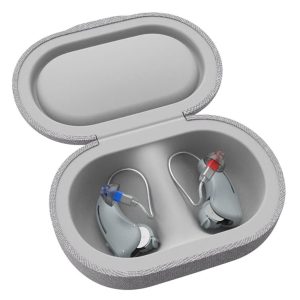

Key product features
What you should know
The Lexie B1 hearing aids, powered by Bose technology, excel in meeting the needs of older adults with their straightforward setup, user-friendly interface, and personalized sound adjustments, ensuring an enhanced listening experience without compromising on affordability.
- Our product testers found the setup to be very intuitive and the app easy to understand with plenty of images, videos, and graphics to explain how to fit the devices into your ears.
- Affordability is often a crucial factor for older adults, and Lexie B1 hearing aids often provide a cost-effective solution without sacrificing quality.
- The Lexie B1 hearing aids are an excellent choice for older adults because they are designed with the unique needs of seniors in mind.
- The Lexie B1s also feature user-friendly controls and interfaces, making them accessible and easy to operate if you are not very tech-savvy or have problems with dexterity.
Why we like Lexie B1 as best for seniors
The Lexie B1 hearing aids are an excellent choice for older adults because they are designed with the unique needs of seniors in mind. Our product testers found the setup to be very intuitive and the app easy to understand with plenty of images, videos, and graphics to explain how to fit the devices into your ears.
User Experience
The Lexie B1s also feature user-friendly controls and interfaces, making them accessible and easy to operate if you are not very tech-savvy or have problems with dexterity. You can adjust settings and customize your hearing experience with minimal effort.
Sound quality
Additionally, the Lexie B1 is made by Bose, a powerhouse of sound innovation. These hearing aids have impressive Bose technology built right in.
The Lexie B1 also offers personalized sound adjustments, allowing you to fine-tune your hearing aids to match your specific hearing needs. This customization can significantly enhance speech clarity and overall sound quality, ensuring you can engage in conversations and enjoy various listening situations with ease.
Cost
Affordability is often a crucial factor for older adults, and Lexie B1 hearing aids often provide a cost-effective solution without sacrificing quality. They offer the opportunity to improve your hearing and overall quality of life without breaking the bank.
While the devices’ controls are user-friendly, one potential drawback for people with limited vision or dexterity may be the batteries. They can be difficult to change due to their small size and the hearing aids’ small battery doors.
For more insights on this brand, check out our full Lexie hearing aids review.
What customers are saying
Amazon users appreciate the sound quality and the comfortable fit. They also like how they work well in a variety of settings.
“Almost two weeks have passed since my Lexie B1 aids arrived and I could not be happier, boasts verified Amazon reviewer Jim. “They’re not uncomfortable at all, and I can hear! I am 68, and worked in a very noisy environment during my state trooper firearms instructor and siren above my head career. Sounds that I have not perceived in years are clear to me now. I found that the smaller ear bits are more comfortable and efficient than the larger bits. The other evening a pleasant female voice said ‘low battery’ in my ear which kept me from replacing batteries prematurely. The iPhone app is great and easy to use, although sometimes they might not connect but restarting the Bluetooth on the phone sorts that issue out. I wish I had been able to use these for the past ten years, as I have obviously missed a lot in conversation and surroundings. I am impressed with the quality and support. After all, they’re Bose! Color me ecstatic.”
“Besides being comfortable, I sometimes forget I’m wearing them and they definitely improved my hearing. The feature I like the most is the Bluetooth connectivity. The app connects flawlessly. I can do some customization but being able to adjust the volume, bass, and treble is a great feature. I love using the phone during a conversation without going to my ears and pushing buttons. I really thought I would be returning them within the trial period but I’m satisfied. The bluetooth feature has me hooked. I also like the battery powered ones not the rechargeable so I can replace the battery easily when I’m in a hurry.”
James, Verified Amazon reviewer
Many Amazon customers note having issues connecting to the app. Others note having trouble finding the right size for their ears.
Specs
| Style | RIC |
| Battery | Disposable |
| Bluetooth | Yes |
| Prescription | No |
| Warranty | Two years |
| Financing | Yes |
| Dimensions (without wire) | 1.29”L x 0.9”W x 0.1”H |
Best OTC hearing aid: MDHearing
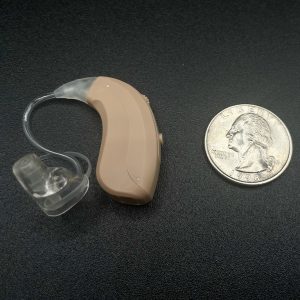

Key product features
What you should know
MDHearing aids stand out for their affordability and ease of access, providing effective solutions for mild to moderate hearing loss. There is an added benefit of lifetime support from U.S.-based specialists, despite a slight learning curve for adjustments.
- The testers appreciated the straightforward controls and settings that empower you to make adjustments independently.
- MDHearing’s hearing aids are known for their low price point, offering a cost-effective option.
- Since they’re sold over the counter, you can purchase them without a prescription or an audiologist appointment.
- The testers found it difficult to learn some of the settings, like how to adjust the volume.
Why we like MDHearing as the best OTC
MDHearing aids have gained a reputation as a reliable brand in the over-the-counter (OTC) hearing aid market (4), earning the trust of many individuals seeking affordable care. While MDHearing devices are sold over the counter, its hearing aids are backed by lifetime support from its U.S.-based audiologists and hearing aid specialists.
Cost
MDHearing’s hearing aids are known for their low price point, offering a cost-effective option if you’re looking to address mild to moderate hearing loss without breaking the bank. Since they’re sold over the counter, you can purchase them without a prescription or an audiologist appointment, making them a convenient choice for quick hearing improvement.
Customization
There are four MDHearing varieties currently on the market:
- NEO XS
- NEO
- VOLT
- AIR
The NEO and NEO XS are in-the-ear (ITE) hearing aids, while the VOLT and AIR are behind-the-ear (BTE). They range in price from $297 to $397 per pair. All are designed with user-friendliness in mind. Our product testers have tested the NEO, VOLT, and AIR models. They appreciated the straightforward controls and settings that empower you to make adjustments independently.
User experience
Our product testers have tested the NEO, VOLT, and AIR models. They appreciated the straightforward controls and settings that empower you to make adjustments independently.
However, they did find it difficult to learn some of the settings, like how to adjust the volume. Otherwise, once they got used to the settings, they had few problems.
While MDHearing may not offer the same level of customization as prescription hearing aids, these devices still provide a noticeable enhancement in hearing clarity and quality, improving the overall listening experience.
Check out our full MDHearing hearing aids review for more information.
What customers are saying
Amazon customers like how MDHearing devices are easy to use, especially for older people with dexterity issues. The sound is clear with no echo. They say they work well for the modest price.
Verified Amazon reviewer William purchased the MDHearing AIR and says, “Overall, I really like these hearing aids. They are easy to charge, although you have to pay attention to make sure they are both charging. The controls are super easy. The sound is digital, meaning that it is a bit thin and sometimes shrill, but overall, it has good sound and very consistent. It does an excellent job of making voices easy to understand.”
“When turning the volume to the max, there is whistling. For average use it is okay.”
Don, Verified Amazon reviewer
“After several weeks, I have been extremely pleased with this product,” boasts verified Amazon reviewer Jim, “ I have slight hearing loss in one ear and moderate loss in the other. From the moment I put the MD hearing aids on, I realized what an amazing difference there was. I was hearing things that I didn’t even know that I was missing. The hearing aids are well made and the controls are easy to master and provide a wide range of volume and programs for various situations. Also, the batteries are rechargeable and that is a real plus. These are great over the counter hearing aids at a great price point. I am hearing things better than I have in years.”
Many negative Amazon reviews note a high-pitch noise in the hearing aids every time they try to adjust them.
Specs
| Style | BTE, ITE |
| Battery | Rechargeable |
| Bluetooth | Yes |
| Prescription | No |
| Warranty | One year |
| Financing | Yes |
| Dimensions | NEO XS (0.43”L x 0.6”W), NEO (0.5”L x 0.875”W), VOLT (1.25”L x 0.25”W x 0.5”H), AIR (1.125”L x 0.25”W x 0.5”H) |
Best Bluetooth hearing aid: Lexie B2
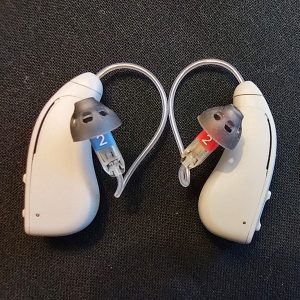

Key product features
What you should know
The Lexie B2 Plus hearing aids feature advanced Bose technology and seamless Bluetooth connectivity and provides exceptional sound clarity. The user-friendly app offers easy customization, making them a cost-effective choice for integrating hearing aids into a digital lifestyle without compromising on quality.
- Our product testers found the clarity to be excellent. Setting up audio streaming on the B2 was a breeze. They also said the streaming sound quality is very strong and clear through their iPhones.
- They do come at a higher price than their counterpart, the Lexie B1 ($849 vs. $999, respectively). However, they’re still a cost-effective option, as some hearing aids can cost $2,000 or more.
- The Lexie B2 Plus hearing aid emerges as an excellent choice for those seeking a Bluetooth-enabled hearing aid due to its blend of cutting-edge technology and user convenience.
- Bluetooth connectivity allows you to wirelessly pair your hearing aids with a wide range of devices, including smartphones, tablets, and televisions.
Why we like Lexie B2 as best Bluetooth
The Lexie B2 Plus hearing aid emerges as an excellent choice for those seeking a Bluetooth-enabled hearing aid due to its blend of cutting-edge technology and user convenience.
Connectivity
Like the Lexie B1, the Lexie B2 is equipped with powerful Bose sound technology and Bluetooth connectivity. Bluetooth connectivity allows you to wirelessly pair your hearing aids with a wide range of devices, including smartphones, tablets, and televisions. With the Lexie B2 Plus, you can effortlessly stream audio directly to your hearing aids, enhancing your listening experience for phone calls, music, and video content.
Our product testers found the clarity to be excellent. Setting up audio streaming on the B2 was a breeze. They also said the streaming sound quality is very strong and clear through their iPhones.
Technology and features
The Lexie B2 Plus hearing aids also come equipped with user-friendly apps that enable you to control and customize your hearing experience via your smartphone. This level of personalization ensures you can adapt their hearing aids to suit your specific preferences and listening environments with ease.
Cost
Additionally, the Lexie brand’s commitment to affordability makes the Lexie B2 Plus hearing aids an attractive option for those seeking Bluetooth-enabled devices without breaking the bank. This combination of advanced connectivity, customization, and cost-effectiveness positions the Lexie B2 Plus as a top choice for anyone who wants to seamlessly integrate their hearing aids with their digital lifestyles while enjoying clear and comfortable sound.
They do come at a higher price than their counterpart, the Lexie B1 ($849 vs. $999, respectively). However, they’re still a cost-effective option, as some hearing aids can cost $2,000 or more.
Check out our full Lexie hearing aids review for more insights on this brand.
What customers are saying
Amazon users love the Bluetooth connectivity of the Lexie B2 Plus hearing aids and that it can stream music and calls, unlike the Lexie B1. They also like how well the app works with their devices.
Verified Amazon reviewer David F. says, “I’ve had them in for almost a week and I have no complaints. Feeling them in my ears is kind of weird and when I think about them I feel like I want to scratch my ears, but only if I’m thinking about them. I wore them while playing music with friends and they really helped in that regard. I could clearly hear my guitar and also my voice when I was singing. I no longer have to turn down the base and turn up the volume and treble on my sound system to understand a narrator reading an audiobook. The free Lexie app is very easy to use and they were easily set up for use. They charge in three hours and the charge is supposed to last for about 15 hours. Overall, I think it was a great investment. I’m very satisfied.”
“The sound quality is great. It is a little difficult to adjust/keep tuned in to individual needs without having to contact customer support, but I think that is due to a ‘technology deficit’ on our part, and nothing to do with the devices themselves. However, customer support were friendly, prompt, courteous, and knowledgeable. They were very professional and willing to help my husband learn and operate his new hearing devices in just one call. It has made a huge difference for him. Now he’s happy and realizes just how much he’s been missing.”
Shannon, Verified Amazon reviewer
Verified Amazon reviewer Tom notes that it takes time to adjust the volume settings to what works for you. He states, “These units do improve hearing overall. The higher frequencies, however, aren’t the sharpest. These are comfortable, and once the proper domes are selected, they work well all day long. The battery life is excellent, easily lasting at a useful level for an entire day. It does take some adjusting of the sound levels and bass and treble to get what works best for you. Overall I recommend these for anyone with moderate hearing difficulties.”
Specs
| Style | RIC |
| Battery | Rechargeable |
| Bluetooth | Yes |
| Prescription | No |
| Warranty | Two years |
| Financing | Yes |
| Dimensions | 1.29″L x 0.9″W x 0.1″H |
Best hearing aid for severe hearing loss: Phonak Audéo Lumity


Key product features
What you should know
The Phonak Audéo Lumity hearing aids provide powerful amplification and exceptional clarity, particularly beneficial for individuals with severe hearing loss. They feature advanced speech enhancement technologies and customizable settings through a user-friendly app for improved communication in noisy environments.
- Our product testers found the multi-function button works great to transition between on/off, phone calls, flight mode, and Bluetooth connectivity.
- These hearing aids come with a range of customizable features, allowing you to fine-tune your devices to your unique preferences and specific hearing needs.
- The Phonak Audéo Lumity hearing aids are designed to provide powerful amplification and exceptional clarity, making them highly effective for those with significant hearing losses.
- The Audéo Lumity hearing aids feature adaptive programs and speech enhancement technologies, helping you better understand speech in noisy environments despite severe hearing loss.
Why we like Phonak Audéo Lumity as best for severe hearing loss
The Phonak Audéo Lumity hearing aids are designed to provide powerful amplification and exceptional clarity, making them highly effective in addressing the needs of those with significant hearing losses (5).
Technology and features
With their advanced technology and robust sound processing capabilities, the Phonak Audéo Lumity hearing aids can accommodate the greater amplification requirements that severe hearing loss often demands. They are a significant step up from Phonak’s Paradise line with added features to help improve your listening experience.
For example, the Audéo Lumity hearing aids feature adaptive programs and speech enhancement technologies, helping you better understand speech in noisy environments despite severe hearing loss. This can greatly improve communication and overall quality of life if you have struggled in challenging listening situations in the past.
Customization
These hearing aids come with a range of customizable features, allowing you to fine-tune your devices to your unique preferences and specific hearing needs. They are also compatible with the MyPhonak mobile app. This app allows you to track additional health data, such as total daily steps and heart rate.
Our product testers found the multi-function button works great to transition between on/off, phone calls, flight mode, and Bluetooth connectivity. But it is pretty small, so if you have difficulty using it, we suggest switching to the app to make these adjustments instead.
Check out our complete Phonak hearing aids review to learn more about this brand.
Specs
| Style | BTE |
| Battery | Rechargeable |
| Bluetooth | Yes |
| Prescription | Yes |
| Warranty | Depends on retailer |
| Financing | Yes |
| Dimensions | 1.2”L x 0.49”W x 0.31”H |
Best CROS hearing aid: Signia Pure Charge
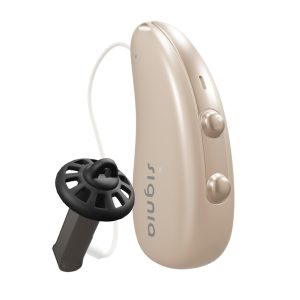

Key product features
What you should know
The Signia Pure Charge CROS hearing aids stand out for individuals with single-sided deafness. They offer innovative sound rerouting for improved sound awareness and speech understanding, coupled with the convenience of rechargeable batteries and Bluetooth connectivity for a more connected, effortless hearing experience.
- The Signia Pure Charge CROS hearing aids are also equipped with lithium-ion rechargeable batteries, reducing the need for constant battery replacements. This feature is particularly beneficial if you have dexterity or mobility challenges.
- The Signia Pure Charge CROS hearing aids require a prescription. You must get an evaluation at a hearing clinic before you can buy them.
- These hearing aids excel in offering a seamless way to improve sound awareness and speech understanding for individuals with single-sided deafness.
- The Signia Pure Charge devices capture sound from the non-hearing ear and transmit it to the ear with better hearing, effectively bridging the gap and allowing you to hear sounds from all directions.
Why we like Signia Pure Charge as best CROS
For individuals with single-sided deafness or significant hearing loss in one ear, traditional hearing aids may not be as effective. Contralateral routing of signals (CROS) technology enables hearing aids to reroute sound between the deaf and hearing ears and can provide an innovative solution for unilaterally deaf individuals (6).
Sound quality
Our pick among CROS hearing aids is the Signia Pure Charge CROS. These hearing aids excel in offering a seamless way to improve sound awareness and speech understanding for individuals with single-sided deafness. It is a small, behind-the-ear device with Bluetooth connectivity. It’s designed to understand your personal hearing environment in greater detail to deliver sound catered precisely to your needs due to its auto-motion sensor technology.
The Signia Pure Charge devices capture sound from the non-hearing ear and transmit it to the ear with better hearing, effectively bridging the gap and allowing you to hear sounds from all directions. This innovative technology enhances overall sound awareness, making it easier for you to engage in conversations and navigate your surroundings more effectively.
Battery type
The Signia Pure Charge CROS hearing aids are also equipped with lithium-ion rechargeable batteries, reducing the need for constant battery replacements. This feature is particularly beneficial if you have dexterity or mobility challenges.
Also, note that the Signia Pure Charge CROS hearing aids require a prescription. You must get an evaluation at a hearing clinic before you can buy them.
For more insights, see our comprehensive Signia hearing aids review.
Specs
| Style | BTE |
| Battery | Rechargeable |
| Bluetooth | Yes |
| Prescription | Yes |
| Warranty | Three years |
| Financing | Depends on retailer |
| Dimensions | IX: 1”L x .25”W |
Best hearing aid for tinnitus: ReSound Omnia


Key product features
What you should know
The ReSound Omnia hearing aids are specifically tailored for those suffering from tinnitus. They feature a built-in Tinnitus Sound Generator and a range of soothing sounds for effective symptom management, although their advanced features may present a learning curve for some users.
- Some users may find the ReSound Omnia more complex and difficult to use compared to other models.
- These hearing aids incorporate specialized features and technology to help manage and alleviate the symptoms of tinnitus, making them a valuable solution if you have both hearing loss and tinnitus.
- ReSound Omnia hearing aids are an outstanding choice if you’re dealing with tinnitus, a condition characterized by the perception of ringing, buzzing, or other noises in the ears.
- One key feature of ReSound Omnia hearing aids is their built-in Tinnitus Sound Generator (TSG). This feature allows you to choose from a variety of soothing, customizable sounds, such as white noise, ocean waves, or gentle melodies.
Why we like ReSound Omnia as best for tinnitus
ReSound Omnia hearing aids are an outstanding choice if you’re dealing with tinnitus, a condition characterized by the perception of ringing, buzzing, or other noises in the ears (7). These hearing aids incorporate specialized features and technology to help manage and alleviate the symptoms of tinnitus, making them a valuable solution if you have both hearing loss and tinnitus.
“Tinnitus is a condition that causes continuous ringing or buzzing in the ears. This can often lead to sleep deprivation in those who experience it,” states Dr. Raj Dasgupta MD, FACP, FCCP, FAASM. “The persistent ringing caused by tinnitus can make it difficult to fall asleep due to distraction and anxiety, resulting in both sleep deprivation and daytime drowsiness.”
To learn more about this brand, visit our full Resound hearing aids review. If you’re looking to alleviate tinnitus symptoms, check out our best hearing aids for tinnitus.
Technology and features
One key feature of ReSound Omnia hearing aids is their built-in Tinnitus Sound Generator (TSG). This feature allows you to choose from a variety of soothing, customizable sounds, such as white noise, ocean waves, or gentle melodies. These sounds can be adjusted to your preference and mixed with their amplified environmental sounds or streamed audio, effectively masking the tinnitus noise and providing relief.
“Sleep deprivation can also worsen tinnitus symptoms. People with tinnitus can improve their sleep by establishing a regular sleep schedule, creating a relaxing bedtime routine, and avoiding caffeine and alcohol before bed.”
Dr. Raj Dasgupta, MD, FACP, FCCP, FAASM, Expert reviewer
Technology and features
Furthermore, ReSound’s comprehensive app ecosystem provides tools to aid in tinnitus management. You can access these apps to further customize your tinnitus relief experience, allowing for real-time adjustments and personalization. However, some users may find the ReSound Omnia more complex and difficult to use compared to other models.
Specs
| Style | ITC, RIE, CIC, BTE |
| Battery | Rechargeable and disposable |
| Bluetooth | Yes |
| Prescription | Yes |
| Warranty | Depends on the retailer |
| Financing | Depends on the retailer |
| Dimensions | 5’’L × 4’’W × 3’’H |
Best rechargeable hearing aid: Starkey Evolv AI
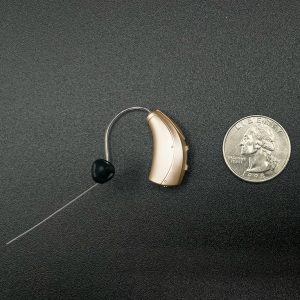

Key product features
What you should know
The Starkey Evolv AI hearing aids lead the pack with their eco-friendly rechargeable batteries and cutting-edge AI technology. They offer sound adaptation and health monitoring features, though they may require some patience to program.
- Evolv AI hearing aids also come equipped with artificial intelligence (AI) technology, which continuously adapts to your listening environments and preferences.
- Rechargeable hearing aids eliminate the need for regular battery replacements, making them eco-friendly and cost-effective in the long run.
- These hearing aids offer long-lasting battery life—up to 24 hours on a single charge—ensuring that users can enjoy uninterrupted hearing throughout the day.
- The Evolv AI also has fall detection and health-monitoring technology to help you keep track of your activity.
Why we Like Starkey Evolv AI as best rechargeable
The Starkey Evolv AI hearing aids are our top choice among hearing aids with rechargeable batteries due to their combination of advanced technology and convenience. Rechargeable hearing aids eliminate the need for regular battery replacements, making them eco-friendly and cost-effective in the long run. With the Starkey Evolv AI, users can enjoy a sustainable and hassle-free hearing solution.
Battery type
One standout feature of the Starkey Evolv AI hearing aids is their powerful rechargeable battery system. These rechargeable hearing aids offer long-lasting battery life—up to 24 hours on a single charge—ensuring that users can enjoy uninterrupted hearing throughout the day. The Evolv AI also has fall detection and health-monitoring technology to help you keep track of your activity.
Technology and features
Evolv AI hearing aids also come equipped with artificial intelligence (AI) technology, which continuously adapts to your listening environments and preferences. This smart technology enhances the overall listening experience, providing clear and natural sound quality. However, AI technology may make these hearing aids more difficult to program or adjust.
Check out our full Starkey hearing aids review for more information about the Evolv AI hearing aids.
Specs
| Style | BTE, RIC, ITE, ITC, CIC, IIC |
| Battery | Rechargeable and disposable |
| Bluetooth | Yes |
| Prescription | Yes |
| Warranty | Two years |
| Financing | Yes |
| Dimensions | Depends on model |
How we tested the best hearing aids
Our methodology for testing hearing aids is designed to provide in-depth insights into their performance, durability, and overall value. Our goal is to empower you with information that guides you toward making an informed decision when choosing the hearing aid that best fits your lifestyle and needs. Read our hearing aids testing methodology for an expanded review of each factor.
Performance (auditory effectiveness) – 40%
This category is foundational in evaluating hearing aids as it directly relates to the device’s primary function: enhancing the user’s hearing ability. This category delves into the core functionality of hearing aids, scrutinizing how effectively these devices can amplify sound, improve speech intelligibility, and provide a natural listening experience across various settings and scenarios to meet the diverse needs of the users.
Here’s what we’re looking for:
- Sound quality
- Noise reduction
- Feedback control
- Programmability and connectivity
Features – 30%
The features of a hearing aid encompass a detailed examination of the functionalities and technological innovations that distinguish each device. By evaluating the features of hearing aids, we aim to highlight the capabilities that contribute most significantly to improving the quality of life for individuals with hearing loss. The features of a hearing aid can directly impact user comfort, satisfaction, and, ultimately, the willingness to use the device consistently. We evaluate:
- Durability
- Battery options
- Hearing loss range
- Wireless connectivity
- Water resistance
- Safety features
Value – 20%
Evaluating hearing aids involves a comprehensive analysis of the device’s overall cost-effectiveness, affordability, and long-term benefits to the user. It directly impacts the user’s decision to purchase the hearing aid, balancing the financial investment against the expected improvements in hearing quality, lifestyle enhancements, and the array of features provided.
Value does not simply reflect the initial purchase price but incorporates a broader perspective, including the device’s durability, performance, maintenance costs, and the extent to which it meets the user’s specific hearing needs.
Our factors in this rating include:
- Insurance coverage
- Financing options
Customer experience – 10%
Customer experience determines all aspects of the user’s interaction with the hearing aid brand, from the initial inquiry and purchase process to ongoing support and service. A positive customer experience ensures that users feel valued and supported and facilitates optimal use of the hearing aid, enhancing the likelihood of successful hearing outcomes.
Our factors in this rating include:
- Shipping
- Warranty
- Customer support
How we chose the best hearing aids
We combined real, hands-on user testing with deep industry knowledge to narrow the market down to a few top choices. Then, we relied on fact-checkers and medical reviewers to ensure our list was complete and accurate.
Our team chose the best hearing aids by considering consumer-focused criteria, such as performance, features, value for the price, and customer experience. These factors combine to provide a full picture of the user’s experience from start to finish.
Hearing aids that didn’t make our list
Our rigorous testing process and honest reviews aim to pinpoint the best hearing brands and models while recognizing that others won’t meet our high standards. While some brands below were close contenders, barely falling behind our top models, others were less impressive or raised genuine concerns.
- Go Hearing: The OTC hearing aids from Go Hearing initially hit the market as some of the most affordable, but the competition has stiffened. However, the Go Ultra model remains on our best affordable hearing aids list for its high-quality sound, noise reduction capabilities, and memory recall feature. At $199 to $499 a pair, Go Hearing offers competitive pricing and impressive battery life, with its rechargeable batteries lasting up to 20 hours of use.
- Lucid Hearing: Lucid Hearing offers several OTC hearing aid options, including ITE and BTE styles. Some inexpensive options cost just $199, while other models are priced between $999 and $1,299. These hearing aids didn’t impress us as much because they lacked features for the price.
- Nano: Nano offers rechargeable BTE, ITE, and CIC models that cost between $247 and $697. With such affordable prices, we wanted to like this brand. However, its hearing aids lack many features that other inexpensive brands include, and the company has been scrutinized for its business practices. It faced a lawsuit from the Vermont Attorney General accusing it of misleading its consumers through various claims, such as the accuracy of its hearing test, implying FDA approval, promoting its products for children, and claiming its products are designed in the U.S. when they’re actually from China. (8)
- Nebroo: As a newcomer to the hearing aid industry, Nebroo hasn’t earned our recommendation. Its product information is limited and confusing, and its privacy policy is concerning. It states that the company may share your information with third parties, such as electronic communication providers, banks, the postal service, and suppliers in China. We encourage sticking with more reputable companies.
- Orka Two: The Orka Two hearing aids boast plenty of customization opportunities and advanced features that may appeal to tech-savvy users. The customer service team is excellent, and the streaming capabilities are easy and convenient. Unfortunately, the $1,899 price tag may not be in the budget for many consumers, especially those who are less comfortable with technology or won’t use all the features. Another downside is the short 12-hour rechargeable battery life.
How to choose the best hearing aid for you
Choosing the right hearing aid is a significant decision that can greatly impact your overall quality of life. Here are several important factors to consider before buying a hearing aid:
Hearing loss type
Before purchasing a hearing aid, it’s crucial to undergo a comprehensive hearing evaluation by an audiologist or hearing specialist ( 9 ). They will assess your hearing loss type, degree, and specific needs. This evaluation will guide selecting and customizing the right hearing aid for you.
Hearing aid style
Different hearing aid styles are available, from behind-the-ear (BTE) to completely in-the-canal (CIC) models (see types of hearing aids, above). Your choice depends on your cosmetic preferences, dexterity, and the severity of your hearing loss. Discuss these options with your audiologist to find the most suitable style.
Technology level
Hearing aids come in various technology levels, from basic to advanced. Consider your lifestyle and daily listening environments. If you’re frequently in noisy or challenging settings, you may benefit from more advanced features like noise reduction, directional microphones, and Bluetooth connectivity.
Customization
Hearing aids should be customized to your individual hearing profile and needs. Ensure that your audiologist or hearing specialist fine-tunes the settings to address your unique requirements for amplification, frequency response, and sound processing.
Cost and insurance
Hearing aids can vary widely in price from as little as $99 to $7,500 or more a pair, so establish a budget beforehand. Additionally, check if your insurance or any financial assistance programs can help cover the cost of hearing aids.
Trial period
Many hearing aid providers offer a trial period—usually 30 to 60 days—during which you can test the device in different real-life situations. This allows you to assess its effectiveness and comfort before deciding.
Maintenance and repairs
Consider the maintenance requirements and potential repair costs of your chosen hearing aid. Some models may require more frequent servicing or battery replacement.
Warranty
Inquire about the warranty coverage for your hearing aid, including the length of the warranty and what it covers. Most companies offer at least a 12-month warranty. This can be crucial in case your device needs repairs or replacement parts.
Battery life
Depending on the style and technology, hearing aids may use disposable or rechargeable batteries. Consider which option suits your lifestyle and preferences. For example, if you are more active, you may prefer disposable batteries, so you only have to change them every three to 22 days. Or, if you are more concerned about the environment, you may prefer a rechargeable option. Also, be aware of the expected battery life.
Accessories and connectivity
If you have specific connectivity needs, such as directly streaming audio from your phone or TV to your hearing aids, ensure that the chosen device is compatible with the necessary accessories and technology.
Comfort and fit
Hearing aids should fit comfortably and securely in your ears, especially if you are more active and want to ensure they don’t slip loose. Discuss any concerns about comfort and fit with your audiologist to ensure adjustments can be made.
Follow-up care
Be aware of any ongoing care and follow-up appointments that may be required for your hearing aids. Regular check-ups, adjustments, or cleaning may be necessary to maintain optimal performance.
Expectations
Finally, realistic expectations are essential. Hearing aids can significantly improve your hearing, but they may not fully restore your hearing to its natural state. Understand what your hearing aids can and cannot do.
Types of hearing aids
There are several types of hearing aids available, each designed to cater to specific hearing loss needs and preferences of individuals (9). Here’s an overview of the different types:
- Behind-the-ear (BTE): BTE hearing aids are among the most common and versatile types. They consist of a small plastic case that rests behind the ear, connected to an earmold or a thin tube that directs sound into the ear canal. BTE hearing aids are suitable for a wide range of hearing losses and are often preferred for their durability and ease of handling.
- In-the-ear (ITE): ITE hearing aids are custom-made to fit inside the ear canal or fill the outer ear’s bowl-shaped area. They are less visible than BTE devices but may be more noticeable than smaller styles. ITE hearing aids are suitable for mild to moderate hearing loss and offer convenient controls and features.
- In-the-canal (ITC) and completely-in-the-canal (CIC): ITC and CIC hearing aids are even smaller and more discreet than ITE models. They fit partially or completely inside the ear canal, making them less visible. However, due to their size, they may have fewer features and controls. They are suitable for mild to moderate hearing loss and are preferred for their cosmetic appeal.
- Receiver-in-canal (RIC) or receiver-in-the-ear (RITE): RIC hearing aids are similar in design to BTE devices but with a thinner wire or tube connecting the case to the receiver (speaker) inside the ear canal. This design allows for a more open and comfortable fit while providing excellent sound quality. RIC hearing aids are versatile and suitable for various hearing loss levels.
- Invisible-in-the-canal (IIC) and completely-in-the-canal (CIC): These are the smallest and most discreet hearing aids, as they fit deep inside the ear canal and are virtually invisible when worn. IIC and CIC hearing aids are custom-made to fit each individual’s ear canal shape. They are ideal for individuals with mild to moderate hearing loss and those who prioritize discretion.
- Bone conduction hearing aids: Unlike traditional hearing aids, bone conduction devices work by transmitting sound vibrations through the bones of the skull to the inner ear, bypassing the ear canal and middle ear. These are suitable for individuals with conductive or mixed hearing loss, where sound cannot effectively reach the inner ear through the normal route.
- Disposable hearing aids: These are budget-friendly, pre-programmed hearing aids designed for temporary or occasional use. They are typically available over the counter and are not custom-fitted. Disposable hearing aids are a cost-effective solution for individuals who need short-term hearing assistance.
Digital vs. analog hearing aids
When selecting hearing aids, you may have the option to choose between analog hearing aids and digital hearing aids—though analog hearing aids are becoming less common. These two types of hearing aids function in different ways but they both can improve your hearing.
With analog hearing aids, sounds and speech are amplified similarly—the receiver sends sounds, regardless of what they are, into your ear and does not differentiate between background noises and speech sounds. However, analog hearing aids contain a microchip that can be programmed for different settings like restaurants, at home, or sporting events. To control the settings, you click the hearing aid button to select which setting you want to use.
Meanwhile, digital hearing aids rely on tiny computers in the hearing device that convert sounds into digital signals. This process results in a more precise duplication of the sound you’re hearing. Because of their unique technological design, digital hearing aids can distinguish between speech sounds and environmental sounds. This gives them more clarity when amplifying sounds and filtering out unwanted noises like background noise and feedback.
Determining which version is best for you depends on your hearing loss, budget, and goals. Your healthcare provider can help you decide which would be best to address your hearing.
How much do hearing aids cost?
The cost of hearing aids can vary widely based on several factors, including the type of hearing aid, its features and technology level, the brand, and where you purchase them. On average, you can expect to pay anywhere from a few hundred dollars to several thousand dollars per hearing aid.
In addition to the cost of the hearing aids themselves, you may need to factor in expenses for hearing assessments, fitting and programming appointments, accessories (such as batteries or cleaning kits), and ongoing maintenance and servicing.
It’s also important to consider that most individuals with hearing loss require two hearing aids (one for each ear) to achieve balanced and effective hearing. Therefore, the total cost is often double the price of a single hearing aid.
Keep in mind that some insurance plans may cover part or all of the cost of hearing aids, so it’s worth checking with your insurance provider. Additionally, some hearing aid manufacturers and hearing care professionals offer financing options to help make hearing aids more affordable.
How to save money on hearing aids
In some cases, you may not have to settle for paying the full cost of hearing aids, at least not upfront. Some hearing aid manufacturers and hearing care professionals offer financing options to help make hearing aids more affordable through smaller, incremental payments. You may also qualify for one of the many programs that offer discounted or free hearing aids, such as Veterans Affairs or specific nonprofit organizations like Helping America Hear, the Starkey Hearing Foundation, and the Hearing Aid Project.
Additionally, some insurance plans, including many Medicare Advantage plans, Medicaid, and some private insurances, may cover part or all of the cost of hearing aids, so it’s worth checking with your insurance provider. If that’s not the case for you, consider using your HSA or FSA card to pay for your devices tax-free.
Finally, make sure you shop around and compare prices. Having a wide variety of retailers selling these devices gives you the opportunity to look for the best deal and sales events. For example, wholesale clubs often have excellent deals on hearing care and devices, including Costco hearing aids.
How to buy hearing aids
There are several ways to buy hearing aids. Many over-the-counter and direct-to-consumer hearing aids are available that do not require an audiologist’s involvement. You can purchase them directly from the company’s website or through online retail shops. These hearing aids are designed for individuals with mild hearing loss and are often pre-programmed for general use. They can be more affordable and accessible than prescription hearing aids, but they may not offer the customization and professional care that you would receive with prescription hearing aids.
Individuals with specific needs or more complex or severe hearing loss may benefit more by scheduling an appointment with an audiologist or hearing care specialist. During this assessment, they will evaluate the type and extent of your hearing loss and gain valuable insights into your unique hearing requirements.
Once your hearing assessment is complete, discuss with your audiologist your lifestyle and personal preferences. Factors like your work environment, social activities, and technology preferences will help shape the selection of hearing aids that best align with your needs. Your audiologist will present you with a range of hearing aid options, explaining various styles, technology levels, and features available in the market.
When you’re ready to make a decision, discuss the cost of the hearing aids, including insurance coverage and financing options. Clarify the total expenses, encompassing assessments, fittings, and any subsequent appointments for adjustments and maintenance.
Upon selecting your hearing aids, your audiologist will take impressions of your ears (if custom-fit models are chosen) and meticulously adjust the settings to match your hearing profile. They will provide comprehensive instructions on inserting, removing, and maintaining your hearing aids, as well as guidance on using any accompanying accessories or features. Regular follow-up appointments are essential to fine-tune the devices and address any concerns you may have.
Keep in mind that many providers of OTC and prescription hearing aids offer free trial periods which allow you to experience the comfort and performance of the devices in your everyday life, ensuring they meet your expectations. If you’re not satisfied with the hearing aids you’ve chosen, you can send them back within the trial period, provided the company offers a free trial and you return them within the specified time frame.
Does Medicare cover hearing aids?
When purchasing hearing aids, you may have to pay out-of-pocket for them—or find another avenue to cover the costs because Medicare typically does not cover the cost of hearing aids. One option is to see if your state has an agency devoted to helping those who are deaf and hard of hearing. Visit the National Association of State Agencies of the Deaf and Hard of Hearing website and search their database to see if your state is listed. (11) They sometimes have ways to assist people in getting hearing aids at a lower cost.
Several nonprofit groups will offer financial help, such as the Foundation for Sight and Sound, Starkey Hearing Foundation, Hearing Aid Project, and Miracle-Ear Foundation. (12) If you’re a veteran, you can check with Veteran Affairs to see if they will cover the cost. Meanwhile, children and young adults under age 21 with Medicaid can usually expect to have their hearing aids covered. (13)
Prescription vs. OTC hearing aids
Prescription hearing aids and over-the-counter (OTC) hearing aids serve different purposes. Prescription hearing aids can treat any level of hearing loss—mild to profound—and are appropriate for both kids and adults, while OTC hearing aids are designed only for people over the age of 18 with mild to moderate hearing loss.
Many people with mild to moderate hearing loss choose OTC hearing aids for their cost and easy access. You should weigh the additional benefits and disadavantages before deciding.
Pros of OTC hearing aids
- Can be purchased without a prescription
- Cost significantly less than prescription hearing aids
- Can find them online, in a pharmacy, and in some large retail stores
- You can fit them and adjust them yourself
Cons of OTC hearing aids
- Not customized to your specific hearing loss
- No in-person support to ensure proper fit and programming
- May not offer as many advanced features as prescription devices
Prescription hearing aids, on the other hand, can treat any level of hearing loss from mild to profound. These devices offer their own set of perks and pitfalls.
Pros of prescription hearing aids
- A hearing professional will assess your specific hearing needs
- Offers more customization for fit and programming based on your ear shape and hearing loss
- Typically includes ongoing support and adjustments
- Often have more advanced technology features than OTC hearing aids
Cons of prescription hearing aids
- Generally more expensive than OTC hearing aids
- May take longer to receive due to customization
- Require ongoing provider visits for assessments and adjustments
How to care for your hearing aids
While caring for your hearing aids will vary depending on the type and the manufacturer’s instructions, there are some basic things you can do to keep them in good working order. For instance, you should plan to wipe the wax and oils off of your hearing aids each time you take them out. Doing so will keep them clean and sanitary and prevent buildup that can cause issues down the road.
You also should use an approved disinfectant spray—as long as this is recommended in your owner’s manual. Also, try to store your hearing aids in a safe, dry location. Caring for your hearing aids consistently will help extend the life of your devices. It also will prevent issues and reduce the number of repairs you need. But more importantly, proper care ensures you continue to hear at the level you have come to expect.
FAQs
How long do hearing aids last?
The lifespan of hearing aids can vary depending on factors like the quality of the device, usage, maintenance, and technological advancements. On average, hearing aids typically last between three to seven years. However, some users may replace them sooner to take advantage of newer features and improved technology. Others may extend their lifespan with proper care and maintenance. Regular cleaning, servicing, and keeping up with advances in hearing aid technology can help maximize their longevity.
How do I know if I need a hearing aid?
If you suspect you may need a hearing aid, there are common signs to watch for, including:
- Difficulty hearing conversations, especially in noisy environments
- Frequently asking people to repeat themselves or misunderstanding words
- Turning up the volume on the TV or radio to levels others find too loud
- Avoiding social situations or becoming withdrawn due to communication difficulties
- Tinnitus (ringing or buzzing in the ears) or ear pain
If you experience any of these signs, it’s essential to schedule a hearing evaluation with an audiologist or hearing healthcare professional. They can assess your hearing and recommend appropriate solutions, which may include hearing aids if hearing loss is detected.
How long does it take to get a hearing aid?
The timeline for obtaining a hearing aid typically takes about one to two weeks from the initial hearing evaluation to receiving and fitting the hearing aid. This time frame includes the evaluation itself, selecting the appropriate hearing aid model, ordering it, and customizing it to your specific hearing needs. In some cases, more complex hearing loss or special requests may extend the process. Most individuals can expect to have their hearing aid within a few weeks of their initial appointment.
What is the best hearing aid brand?
Determining the “best” hearing aid brand is subjective and depends on individual needs, preferences, and the type and degree of hearing loss. Several reputable hearing aid manufacturers, including Phonak, ReSound, Signia (formerly Siemens), Starkey, and others, consistently produce high-quality devices. The best brand for you will depend on factors like your specific hearing requirements, budget, lifestyle, and, if possible, the expertise of your audiologist or hearing care professional.
Which hearing aid is best for clarity of speech?
Our testing revealed that Jabra and Phonak both offer hearing aids with excellent clarity of speech. Featuring advanced sound processing technology, the Jabra Enhance Select 300 and Phonak Audéo Lumity hearing aids provide expecptional speech enhancement that provide incredible clarity in various listening environments.
Do expensive hearing aids make a difference?
Expensive hearing aids typically have more advanced features and technology than cheaper options, which can significantly improve the listening experience for many individuals. However, that doesn’t mean they’re the best fit for everyone. You should consider your individual needs, preferences, budget, and lifestyle to help determine which hearing aids best suit you. Some less expensive hearing aids still provide excellent sound quality and basic features that may be enough for those who don’t need all of the other bells and whistles.
Which is better: in-the-ear or behind-the-ear hearing aids?
When it comes to choosing between in-the-ear or behind-the-ear hearing aids, the best choice for you will depend on your personal preference, your individual needs, your hearing goals, and your budget. For instance, some people prefer the discreteness of in-the-ear (or in-the-canal) hearing aids. They also prefer this style’s ease of use and simplicity—though some people find it hard to get used to having something in their ear—especially because it can make them feel like their ears are plugged.
Meanwhile, other people prefer behind-the-ear hearing aids because they offer a wide range of hearing amplification, while in-the-ear hearing aids can have limited capabilities due to their small size. People also like that behind-the-ear hearing aids are a little bigger and easier to handle—especially if they struggle with fine motor skills. Ultimately, the best choice is to find a provider who will let you test the hearing aids to see which style you like best.
Are Costco hearing aids as good as others?
Costco offers a range of reputable prescription hearing aid brands, such as Jabra, Lexie, Phillips, and Rexton. These high-quality models have advanced features like Bluetooth connectivity and AI technology, making them comparable to many other prescription devices on the market. Plus, Costco enhances the experience by offering exceptional customer support and follow-up care.
Our experts
Dr. Raj Dasgupta, MD, FACP, FCCP, FAASM
Quadruple-board certified in pulmonary, sleep, internal, and critical care medicine. An active clinical researcher, Dr. Raj currently practices at the University of Southern California, where he’s been awarded the Excellence in Teaching award six years in a row. He’s also an associate professor of clinical medicine, assistant program director of the internal medicine residency program, and the associate program director of the sleep medicine fellowship at USC.
Krista Manning
Krista Manning is an accomplished medical copy editor and fact-checker who stands out in the pharmaceutical, health, and wellness domains. With a meticulous eye for detail and a command of medical language, Krista ensures the accuracy and clarity of content. Beyond her professional expertise, Krista is an advocate for mental health awareness. Recognizing the crucial intersection of psychological and physical well-being, she actively contributes to projects that promote mental health awareness within the healthcare narrative. Krista’s commitment extends beyond the pages she edits, emphasizing the holistic nature of health communication.

Jennifer Walker-Journey
Fortune Recommends Writer
About Author
Jennifer writes on a variety of topics from law, healthcare, eldercare, and pharmaceutical products to food, travel, and consumer products. Her clients include law firms, healthcare systems, financial corporations, public health entities, and digital marketing firms.

